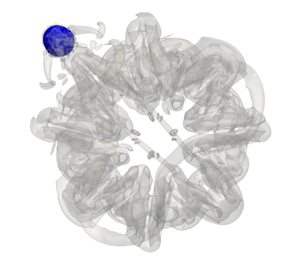Article contents
Modification of flow transition for a vortex ring by a bubble released at the axis
Published online by Cambridge University Press: 19 July 2023
Abstract

The interactions between a vortex ring and a gas bubble released at the axis are studied numerically, which shed light on understanding more complicated bubble–turbulence coupling. We fix the Reynolds number at  $Re_{\tau }=7500$ and consider various Weber numbers in the range of
$Re_{\tau }=7500$ and consider various Weber numbers in the range of  $We=130\unicode{x2013}870$. We find that the translating speed of the vortex ring is substantially lower than the case of the vortex ring without a bubble. It is explained with two different mechanisms, depending on the Weber number. In the low-
$We=130\unicode{x2013}870$. We find that the translating speed of the vortex ring is substantially lower than the case of the vortex ring without a bubble. It is explained with two different mechanisms, depending on the Weber number. In the low- $We$ range, the reduction of translating speed of the ring is due to the capture of bubbles into the ring core, leading to significant changes in the vorticity distribution within the core. In the high-
$We$ range, the reduction of translating speed of the ring is due to the capture of bubbles into the ring core, leading to significant changes in the vorticity distribution within the core. In the high- $We$ range, the repeatedly generated secondary vortex rings perturb the primary one, which bring about an earlier flow transition, thereby reducing the translating speed of the vortex ring. On the other hand, the evolution of a gas bubble is also affected by the presence of the vortex ring. In the low-
$We$ range, the repeatedly generated secondary vortex rings perturb the primary one, which bring about an earlier flow transition, thereby reducing the translating speed of the vortex ring. On the other hand, the evolution of a gas bubble is also affected by the presence of the vortex ring. In the low- $We$ range, we observe binary breakup of the bubble after it is captured by the primary vortex ring. In contrast, in the high-
$We$ range, we observe binary breakup of the bubble after it is captured by the primary vortex ring. In contrast, in the high- $We$ range, it is interesting to find that the bubble experiences sequentially stretching, spreading and breakup stages. In the high-
$We$ range, it is interesting to find that the bubble experiences sequentially stretching, spreading and breakup stages. In the high- $We$ range, the numbers of smaller bubbles predicted by the classical Rayleigh–Plateau instability of a stretched cylindrical bubble agree well with our numerical simulations. Consistent with the previous experiments, this number keeps unchanged at 16 as
$We$ range, the numbers of smaller bubbles predicted by the classical Rayleigh–Plateau instability of a stretched cylindrical bubble agree well with our numerical simulations. Consistent with the previous experiments, this number keeps unchanged at 16 as  $We$ further increases. An additional comparison is made between two higher Reynolds numbers, indicating that the finer eddies in a vortical field with a higher Reynolds number tend to tear the bubble into more fragments.
$We$ further increases. An additional comparison is made between two higher Reynolds numbers, indicating that the finer eddies in a vortical field with a higher Reynolds number tend to tear the bubble into more fragments.
- Type
- JFM Papers
- Information
- Copyright
- © The Author(s), 2023. Published by Cambridge University Press





